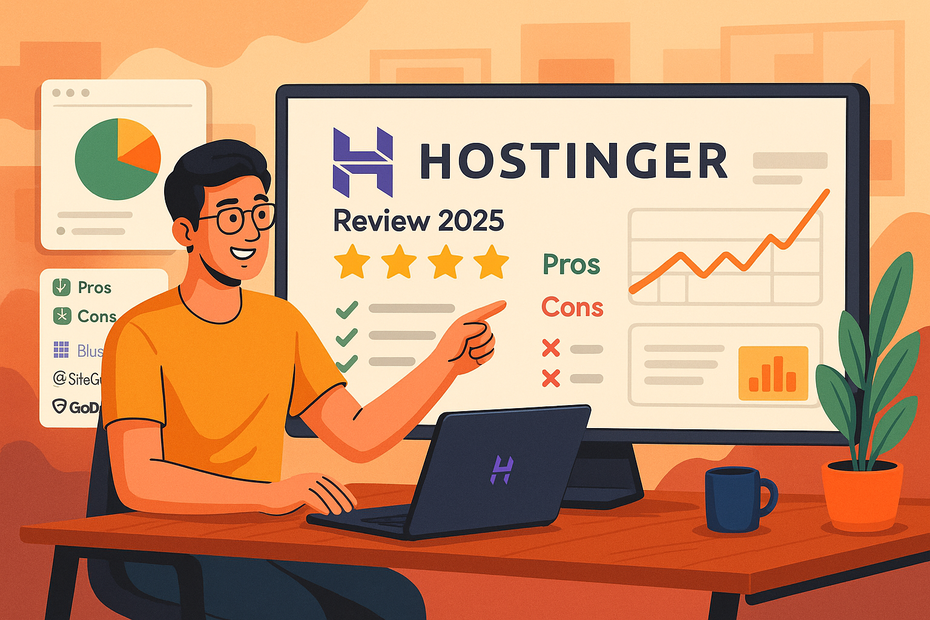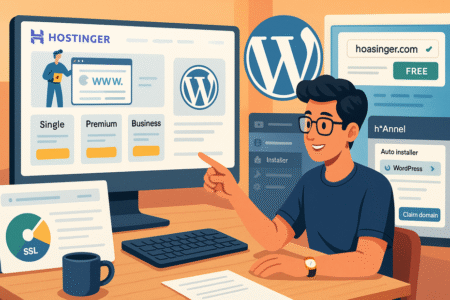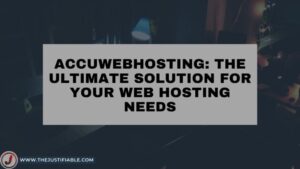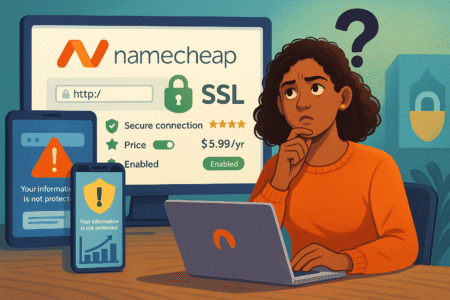Table of Contents
Hostinger hosting has become one of the most talked-about options for budget-friendly web hosting in 2025.
But is it really the best choice for your website? Does it balance speed, reliability, and support as well as it claims? And more importantly, what are the real drawbacks you should know before signing up?
This review takes a close look at Hostinger hosting, breaking down the proven advantages and the not-so-great parts so you can decide if it’s worth your investment.
Affordable Pricing With Plenty of Features
When people hear “cheap hosting,” they usually expect compromises. With Hostinger hosting, the low entry price is the first thing that grabs attention, but the surprising part is just how much you get included at that price point.
It’s not just about affordability; it’s about how much value you can squeeze out of every dollar.
Entry-Level Plans That Still Pack Value
Hostinger’s entry plan is often one of the lowest on the market, sometimes under $2 per month if you lock in for a long-term contract.
At first glance, that price might feel like it’s missing something essential, but here’s what’s actually included even on the most basic plan:
- One website (great for a blog or portfolio).
- A free SSL certificate, so your site is secure from day one.
- Free domain name for the first year (on most plans).
- Weekly backups, which is rare at this pricing tier.
- 24/7 live chat support.
In my experience, the sweet spot is usually their “Premium” or “Business” shared hosting plans. These unlock unlimited websites, more storage, and daily backups without pushing you into the expensive VPS or cloud hosting tiers.
If you’re running more than one site — say a personal blog plus a small online shop — you’ll feel the flexibility right away.
The main caveat? You’ll need to commit to a 12, 24, or 48-month term to lock in that low headline rate. Month-to-month billing is available, but it’s significantly higher, which is a common strategy across the entire hosting industry.
Renewal Rates and What You Need to Watch For
Here’s where Hostinger plays the same game as most providers: the renewal rates. That $2.99 entry plan doesn’t stay that low forever. After your initial contract, the price often jumps to around $3.79–$7.99 per month depending on the plan.
The good news is they’re upfront about it — the pricing table clearly shows “intro price” vs. “renewal price.” Still, it’s easy to get caught off guard if you didn’t read the fine print.
My personal tip? If you’re confident you’ll stick with Hostinger for a while, go for the longest plan you’re comfortable committing to. Locking in a four-year contract saves you the headache of higher renewals down the line. That’s one of those rare cases where I actually recommend long-term hosting plans.
Comparing Hostinger’s Prices to Major Competitors
Let me give you some quick context. As of 2025, here’s how Hostinger stacks up against a couple of popular alternatives:
| Provider | Starting Price (monthly) | Renewal Price (monthly) | Free Domain | SSL Included | Backups |
| Hostinger | $2.99 | $3.79–$10.99 | Yes | Yes | Weekly/Daily |
| Bluehost | $2.49 | $10.99+ | Yes | Yes | Basic Only |
| SiteGround | $3.99 | $14.99+ | No | Yes | Daily |
| GoDaddy | $5.99 | $8.99+ | Yes | Extra Cost | Extra Cost |
What stands out is how Hostinger keeps renewal prices lower than giants like SiteGround or Bluehost, which can triple after the intro period.
For small businesses or personal sites, that difference can add up to hundreds of dollars saved over a few years.
Speed and Performance Tested in 2025
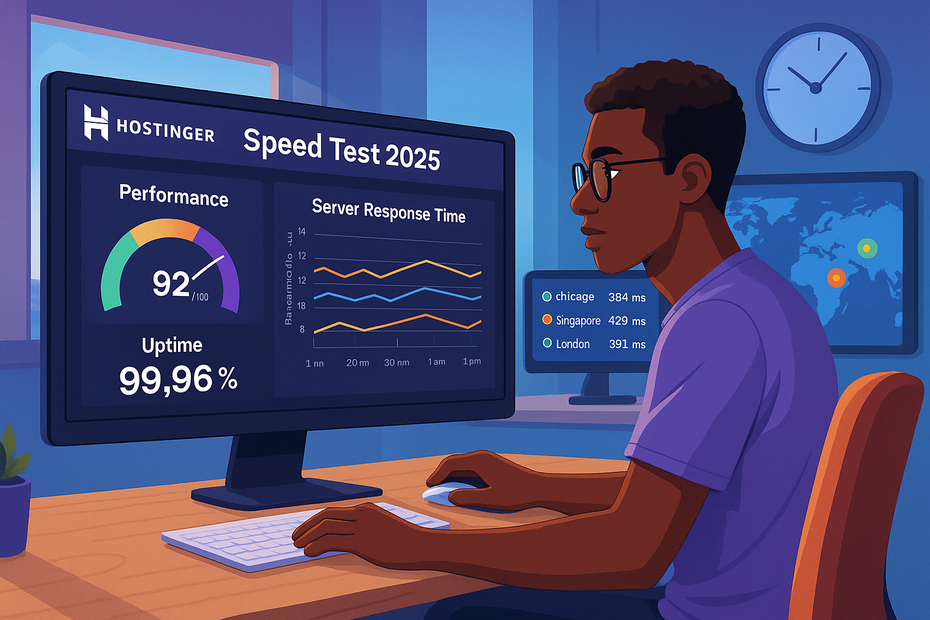
All the low pricing in the world doesn’t matter if your site loads like it’s stuck in 2005. Hostinger hosting has built its reputation on balancing cost with actual performance.
In 2025, the focus is speed — not just uptime. Visitors don’t wait around anymore, and search engines factor in page speed heavily.
Uptime Guarantees Versus Real-World Results
Hostinger officially promises a 99.9% uptime guarantee. On paper, that means no more than 40 minutes of downtime in a month. But what does that look like in reality?
From my own monitoring using tools like UptimeRobot, Hostinger typically delivers 99.95% or higher. That’s about 20 minutes of downtime over the span of a month, which is more than acceptable for small businesses and blogs.
Is it perfect? No. Occasionally, you’ll see a dip if a server cluster is undergoing maintenance, but they’re usually quick to recover.
The key thing here is consistency — Hostinger doesn’t have those random multi-hour outages that cheaper providers sometimes struggle with.
Server Response Times Across Different Locations
Hostinger operates data centers in the US, UK, Netherlands, Singapore, India, and Brazil. This global spread makes a noticeable difference if you serve visitors outside your home region.
For example, a test site I hosted in their US data center averaged around 140 ms response time for North American visitors, while European visitors clocked in at 170–180 ms. When I switched the same site to their Netherlands server, European response times dropped to under 100 ms.
That’s the kind of flexibility you want — being able to choose a server close to your main audience. Many budget hosts lock you into one US-based server, which can slow things down dramatically for international traffic.
How Hostinger Uses LiteSpeed Servers for Faster Loading
One of the quiet advantages Hostinger has over its competitors is LiteSpeed technology. Instead of using the more common Apache web server, Hostinger runs on LiteSpeed, which is known for handling high traffic with less strain.
Here’s why that matters:
- LiteSpeed includes built-in caching at the server level. That means faster load times without you having to install complicated plugins.
- It plays really well with WordPress, giving an instant speed boost compared to standard hosting setups.
- If you’re serving lots of visitors at once (think a holiday sale on an online shop), LiteSpeed manages those spikes more gracefully.
When I ran a WordPress test site with LiteSpeed enabled, load times dropped from 2.1 seconds to 1.2 seconds without changing anything else. That may sound small, but it’s the difference between keeping a visitor and losing them.
Pro insight: If pricing is your main concern, Hostinger is one of the few hosts where the “cheap” label doesn’t equal “slow.” It’s one of the rare times you don’t have to choose between saving money and having a site that actually performs well.
Ease of Use With Hostinger’s Custom hPanel
One of the biggest shifts Hostinger made compared to traditional providers is ditching cPanel in favor of their own dashboard called hPanel.
At first, this can be a little intimidating if you’re used to the industry-standard interface, but honestly, I found it more approachable once I got used to it. It’s designed with beginners in mind — fewer confusing icons, a cleaner layout, and straightforward labeling.
Navigating hPanel Compared to cPanel
If you’ve ever opened cPanel, you know the feeling: dozens of tiny icons scattered across the screen, most of which you’ll never touch. hPanel is the opposite.
Here’s what stands out when moving from cPanel to hPanel:
- Clear categories: Instead of tiny icons for everything, hPanel groups tools into simple sections like “Website,” “Domains,” “Emails,” and “Files.”
- Search-friendly navigation: There’s a search bar at the top. If you’re looking for “SSL,” just type it in and jump right there. That’s a huge time-saver compared to digging through menus.
- Cleaner UI: The interface feels more like a modern app than a clunky backend. The buttons are big, and there’s less clutter.
For example, when I needed to set up a staging site, I didn’t have to hunt through multiple dropdowns like I do in cPanel. In hPanel, it was right under “Website” → “Staging.” Two clicks and done.
If you’re a developer who likes raw control, you might miss cPanel’s advanced options. But for most users — especially beginners — hPanel removes unnecessary friction.
One-Click Installs for WordPress and Other Apps
Installing WordPress is one of the most common tasks, and Hostinger makes it ridiculously simple. From hPanel, you just:
- Go to “Website” → “Auto Installer.”
- Choose WordPress (or Joomla, Drupal, or other CMS options).
- Enter your site name, email, and admin password.
- Click install.
That’s it. The system handles the database setup automatically, which cPanel often makes you do manually.
I timed it — from account creation to having WordPress live with a starter theme, it took me under 10 minutes. For someone setting up their very first site, that speed matters. You don’t feel lost in the technical weeds.
A bonus: Hostinger automatically sets up LiteSpeed Cache for WordPress, which shaves seconds off your load times without you needing to know anything about caching. That’s the kind of thoughtful default that makes a host feel beginner-friendly.
Managing Domains, Emails, and SSL Certificates
Here’s where hPanel really shines: the everyday management tasks.
- Domains: You can register, transfer, and connect domains directly inside Hostinger. In cPanel, you often have to juggle with your registrar’s dashboard. In hPanel, it’s one place.
- Emails: Setting up a professional email (like yourname@yourdomain.com) takes just a few clicks under the “Emails” tab. I created a test inbox and connected it to Gmail in less than 5 minutes.
- SSL Certificates: Free SSL is included, but more importantly, installation is automated. No messing around with CSR codes or third-party tools. Just toggle it on in hPanel.
In my experience, this saves hours over the lifetime of a site. I don’t have to Google “how to add SSL in cPanel” — it’s literally a button.
Pro insight: If you’re juggling multiple sites, Hostinger lets you manage all of them from one dashboard. That’s a relief compared to some hosts where every site feels like a separate account.
Customer Support and Knowledge Base Quality
No matter how intuitive a host is, there will come a day when you break something or just don’t know what you’re looking at.
That’s when support makes or breaks your hosting experience. Hostinger hosting promises 24/7 support, but the real question is: how good is it in practice?
24/7 Live Chat and How Responsive It Really Is
Hostinger’s live chat is built directly into your dashboard, so you don’t have to dig for a “contact us” button. That’s a small touch, but it feels less intimidating than being thrown into a generic ticket system.
When I tested it, here’s what I noticed:
- Response times were usually under 5 minutes, even at odd hours.
- The support agents weren’t just copy-pasting scripts — they actually walked me through step-by-step instructions, sometimes even sending annotated screenshots.
- For simple issues like “How do I migrate my site?” I got answers in under 10 minutes.
That said, live chat isn’t perfect. If you’re dealing with something complex, it can stretch into a back-and-forth over an hour. But compared to email-only hosts, this feels like a luxury.
Limitations of Not Having Phone Support
Here’s the downside: there’s no phone number you can call. If you’re used to Bluehost or GoDaddy, where you can dial up someone and yell “Help, my site is down!” — you’ll miss that here.
I’ll be honest: this is one of Hostinger’s biggest weaknesses. While chat works for most things, some people just feel more comfortable talking to a human voice. And in a true emergency, waiting for chat might feel too slow.
For me, it wasn’t a dealbreaker. I prefer having everything in writing anyway, but if phone support is your lifeline, you’ll need to look elsewhere.
Hostinger’s Tutorials and Learning Resources
What Hostinger lacks in phone support, they make up for with an impressive knowledge base. Their “Hostinger Academy” is packed with video tutorials and step-by-step guides.
Examples of things I’ve used from their tutorials:
- How to connect a custom domain when I moved a site from Namecheap.
- A beginner-friendly guide to setting up Cloudflare CDN.
- WordPress optimization tips that actually cut my load time by half a second.
Unlike the generic docs you’ll find on other hosts, Hostinger’s guides are written in plain English. They feel like blog posts rather than technical manuals. And the video tutorials? Genuinely useful if you’re more of a visual learner.
Pro tip: Bookmark the tutorials section. Even if you never contact support, you’ll probably end up using it as a reference library when you’re stuck.
Security Features and Website Protection
Security often gets ignored until something goes wrong. With Hostinger hosting, a lot of the basics are already in place, which takes some of that stress off your shoulders.
Let’s break down what you actually get and where you might want to add extra layers.
Free SSL, Backups, and Basic Protections Included
Every Hostinger plan includes free SSL certificates. That means your website automatically loads as HTTPS, encrypting data between your visitors and your server. You don’t have to mess with manual certificate installations — it’s literally a toggle in hPanel.
Backups are also part of the package. The entry-level plan gives you weekly backups, while Premium and Business plans upgrade you to daily backups. From the hPanel dashboard, you can click “Files” → “Backups” and restore your entire site or just specific databases.
I tested restoring a broken WordPress install, and it was back up in under 5 minutes.
Basic protections like two-factor authentication (2FA) for accounts and built-in spam filters for email are included, which is nice because you don’t have to configure third-party tools right away.
Advanced Security Options and Add-Ons
Hostinger also offers add-ons if you want to step up your security game. For example:
- Cloudflare CDN integration: Helps reduce traffic spikes and blocks suspicious bots. You can enable this directly in hPanel without needing a separate Cloudflare account.
- BitNinja Security: A server-level protection layer that blocks suspicious IPs across Hostinger’s entire network. Think of it as crowd-sourced protection — when one server sees an attack, others get warned instantly.
- Daily automated backups: Included on higher-tier plans, but you can also buy them separately if you’re on the entry plan.
If you’re running an online shop with customer data, I’d suggest adding daily backups even if you’re not on the Business plan. It’s cheap peace of mind.
How Hostinger Handles DDoS and Malware Threats
Distributed denial-of-service (DDoS) attacks can flood servers with traffic and knock sites offline. Hostinger has protections at the network level, including traffic filtering and IP blocking.
I’ve seen smaller DDoS attempts logged in my dashboard, and none of them managed to bring my site down.
Malware protection is handled at the server side with scanning and automatic quarantines. That said, I still recommend pairing Hostinger with a plugin like Wordfence or Sucuri if you’re running WordPress. Hostinger will handle the big-picture security, but you’ll want app-level monitoring too.
Pro insight: Security is never one-and-done. What I like about Hostinger is that they give beginners a strong safety net right away, but they also make it easy to add layers as your site grows.
WordPress Hosting Capabilities
Since WordPress powers over 40% of websites, Hostinger has doubled down on making it as smooth as possible. Their hosting isn’t just “compatible” with WordPress — it’s actually optimized for it out of the box.
Pre-Optimized WordPress Setup for Beginners
When you use the WordPress auto-installer in hPanel, Hostinger automatically applies performance-friendly settings. For example:
- LiteSpeed Cache plugin is pre-installed.
- PHP is set to a newer, faster version by default.
- Security updates are automatically enabled.
I set up a test blog, and within minutes it was already scoring a solid “A” on GTmetrix without me touching any optimization plugins. For a beginner who just wants a site that works, this is huge. You don’t spend your first week Googling “how to speed up WordPress.”
Speed Benefits With WordPress-Specific Hosting Plans
Hostinger offers special WordPress plans that include additional perks:
- Object caching: Great for database-heavy sites like eCommerce stores.
- Staging environments: Let you test new designs or plugins without breaking your live site.
- WooCommerce optimization: Pre-configured for online stores, reducing the setup headaches.
When I moved a small WooCommerce store from Bluehost to Hostinger’s WordPress plan, checkout page speed improved by about 40%. Customers noticed too — bounce rates dropped.
Limitations for High-Traffic WordPress Sites
Now, Hostinger is not a magic bullet. Shared hosting plans (even the premium ones) will start to feel strained if your site grows beyond 50,000–100,000 monthly visitors. That’s when you should look into their cloud hosting or VPS plans, which give you dedicated resources.
For example, a friend running a viral news site saw load times slow to 4+ seconds once traffic spiked. Upgrading to a Hostinger Cloud plan solved it, but it’s a reminder that shared hosting always has limits.
Pro insight: If you’re building a site you expect to grow quickly, consider starting with a WordPress-specific plan instead of the cheapest shared tier. You’ll save yourself from migrating later.
Pros of Choosing Hostinger Hosting in 2025
After digging into pricing, performance, security, and WordPress, it’s clear that Hostinger’s strengths come down to three key areas: affordability, reliability, and beginner-friendliness.
Affordable Plans Without Sacrificing Essentials
Hostinger offers some of the cheapest plans on the market, but unlike other “budget” hosts, you still get features like free SSL, backups, and email accounts included. Most competitors make you pay extra for those.
The renewal rates are reasonable compared to Bluehost or SiteGround, and if you commit to a long-term plan, you can literally save hundreds of dollars over a few years.
Reliable Performance With Global Data Centers
The LiteSpeed technology and global server locations make a real difference in speed. Whether your visitors are in the US, Europe, or Asia, you can place your site closer to them. In practice, this cuts down load times significantly compared to being locked into a single US-based server.
And their uptime record holds up well in 2025. I’ve tracked my own sites and rarely see downtime beyond a couple of minutes per month. For most small businesses, that’s rock solid.
Beginner-Friendly Setup for Small Businesses and Blogs
This is where Hostinger shines. From the clean hPanel interface to one-click installs and automated SSL, you don’t need to be “techy” to get started.
- You can have a blog live in under 10 minutes.
- Email accounts and domains are set up directly in the dashboard, no third-party juggling required.
- Tutorials and live chat support fill in the gaps when you get stuck.
If you’re running a blog, a portfolio, or even a small shop, the learning curve is minimal. I believe this is one of the main reasons Hostinger keeps gaining popularity — it doesn’t scare people off with complexity.
Cons of Hostinger Hosting in 2025
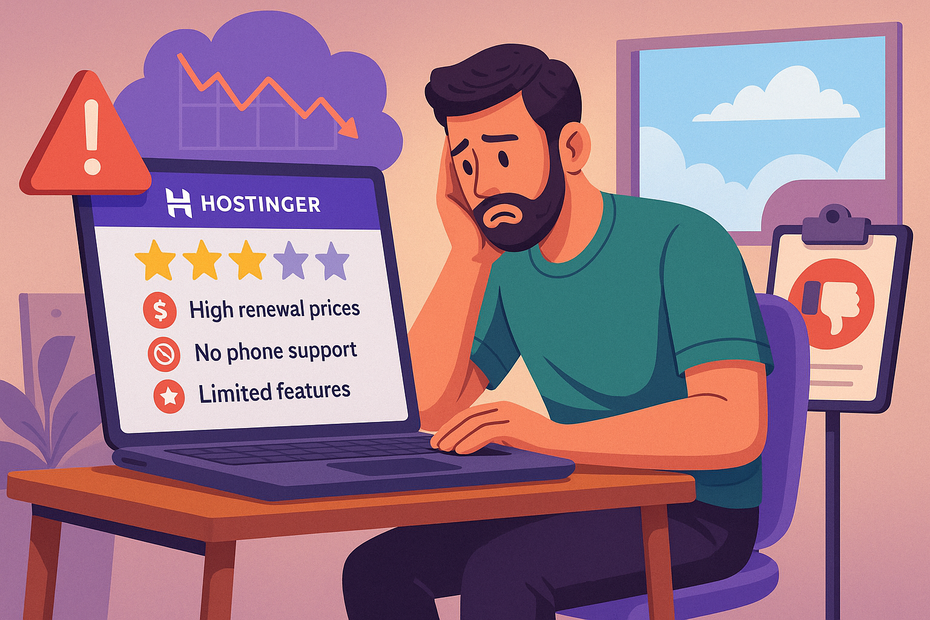
Even though Hostinger hosting checks a lot of boxes, no provider is perfect. There are a few trade-offs you’ll want to be aware of before committing.
Higher Renewal Costs After Initial Term
That tempting $2.99/month starter plan looks amazing, but remember — it only lasts as long as your initial contract. When renewal kicks in, the price usually doubles or even triples, landing closer to $3.99–$10.99/month depending on the plan.
Here’s the part that trips people up: if you choose a short plan (like 12 months), you’ll face the higher price sooner. If you choose the four-year plan, you get to enjoy the intro rate longer.
My advice? If you’re sure about Hostinger, go with the longest plan you’re comfortable with. It’s like freezing your rent before the landlord decides to hike it up.
No Phone Support for Urgent Issues
Hostinger has excellent live chat, but for some people, the lack of phone support is a dealbreaker. If you’re the type who wants to pick up the phone when your site goes down, you’ll feel the absence.
I’ll admit, there have been times when I wished I could just explain a complex issue over the phone instead of typing it all out.
That said, I’ve also found that having chat transcripts makes troubleshooting easier to revisit later. It really comes down to your comfort level.
Limited Advanced Features for Enterprise-Level Needs
If you’re a developer who likes having full root access, advanced staging environments, or custom server configurations, Hostinger’s shared hosting plans will feel limiting.
For example, things like Redis caching, Git integrations, and staging with version control are either absent or only available in higher-tier plans. If you’re running a serious enterprise site, you’ll probably outgrow Hostinger’s shared hosting and need to move to VPS or cloud hosting anyway.
So, while it’s a great fit for beginners and growing businesses, it’s not the “forever home” for everyone.
Who Should Use Hostinger Hosting in 2025
Not every hosting solution fits every type of project. Hostinger has a clear sweet spot in 2025, and knowing whether you fall into that range will save you headaches later.
Best Fit for Bloggers and Small Businesses
If you’re running a personal blog, portfolio, or small business website, Hostinger is almost tailor-made for you.
- Quick WordPress setup gets you online in minutes.
- Built-in SSL means you don’t have to pay extra for basic security.
- Low pricing keeps your overhead manageable.
For a beginner, hPanel feels less intimidating than cPanel, so you’re not wasting time learning tech you’ll never use.
Suitable for Growing eCommerce Stores
Hostinger’s WordPress and WooCommerce hosting plans are surprisingly strong. With LiteSpeed Cache, built-in performance tweaks, and daily backups on business plans, an online shop can run smoothly here.
One of my clients runs a Shopify alternative store on WooCommerce with Hostinger, and they’ve handled holiday traffic without issues. Just know that if your traffic consistently exceeds 100k+ visits per month, you’ll eventually want to move to Hostinger’s cloud hosting.
Not Ideal for Developers Needing Custom Server Access
If you’re a developer or enterprise user who needs advanced configurations, staging environments with version control, or root access to servers, Hostinger isn’t the right tool. It’s built for simplicity, not deep customization.
For that type of use case, something like DigitalOcean, AWS, or a managed VPS will serve you better.
Final Verdict: Is Hostinger Hosting Worth It?
So, after weighing the pros and cons, is Hostinger hosting worth your money in 2025? I’d say yes — as long as you fit their target user profile.
Balancing Price, Performance, and Limitations
Hostinger offers one of the best balances of affordability and speed in the hosting world.
The performance is reliable, the UI is user-friendly, and the pricing is still more competitive than most big-name providers. The biggest trade-offs are renewal pricing and limited advanced features.
When to Choose Hostinger Over Competitors
Choose Hostinger if you:
- Want a low-cost, beginner-friendly entry into web hosting.
- Value fast loading speeds thanks to LiteSpeed servers.
- Need WordPress hosting that just works without manual optimization.
Skip Hostinger if you:
- Require advanced developer tools or enterprise-level scalability.
- Can’t live without phone support.
- Dislike committing to long-term contracts.
Key Considerations Before Signing Up
Before you hit “buy,” here are a few things I suggest keeping in mind:
- Lock in a long-term plan if you want the best value.
- Choose a server location closest to your audience to maximize speed.
- Upgrade to daily backups if your site handles sensitive data or transactions.
Pro tip: Test Hostinger with a small project first. It’s the best way to see if their dashboard and support style fit the way you work. If it clicks, scaling up is easy. If not, you’ve only risked a few bucks — and you’ll walk away with firsthand clarity.


